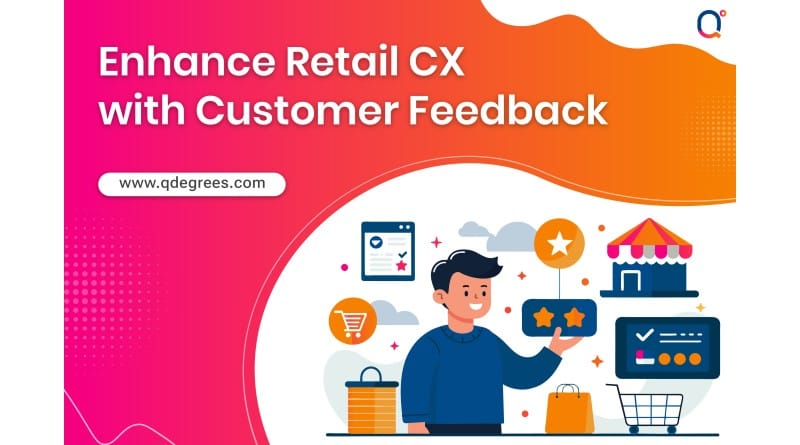Enhance Retail CX with Customer Feedback: Practical Strategies and Trends

Introduction
According to Gartner, for 64% of people, customer experience is more important than the price when it comes to shopping. Based on this stat, you can estimate how a good experience can influence a customer to shop from your retail store.
The reason why it is vital is that multiple factors influence the customer experience itself. So, when you try to improve it, you ultimately make multiple things better about your business.
This blog helps you discover what this retail customer experience is and how you can make it better. For a comprehensive approach to measuring and enhancing your retail CX, consider exploring QDegrees’ Customer Experience Services.
Understand Retail Customer Experience
Retail cx refers to the overall perception of the customers about your retail business after interacting with the store or the brand. Since it gauges the customers’ overall experience, it covers all the touch points.
Simply put, it is not only about how good or bad the quality of your product is. It undertakes multiple key components of a retail business, like service quality, product satisfaction, in-store environment, etc.
A good experience increases customer loyalty and growth, while a bad experience does the opposite. So, there’s no doubt that it’s crucial for the retail business. That brings us to talk about the strategies to enhance your store’s customer experience.
Strategies for Enhancing Retail CX
- Personalization
One of the best ways to enhance your store experience is through personalization. In simple words, you can customize the shopping experience as per your specific customer. In this way, you can make your customers feel more valued and understood. As a result, it will lead to an increase in your loyalty and sales. Furthermore, to offer a personalized experience, you can give tailored recommendations. These recommendations should be based on your customer’s past purchases. You can also take inspiration from Amazon’s recommendation engine or Starbucks’s loyalty app.
- Omnichannel Experience
You can ensure a seamless shopping journey for your customers through an omnichannel experience. You should be accessible to your customers irrespective of channels, whether online, in-store, or via mobile. As a result, you will see increased customer satisfaction. It will also lead to higher sales as customers will be able to switch channels easily. In addition, you can also use strategies like merging offline and online data of your clients. Moreover, providing consistent customer service across all platforms is also very beneficial. So, to do this, you can let your customer order online and pick up in-store. You also let them return items that they bought online at a physical location.
- Employee Training and Engagement
Your employees play a crucial role when it comes to delivering great customer experience. Hence, you need well-trained employees as they are more likely to provide excellent service. You can offer a training program that focuses on product knowledge. Besides, they need to learn customer service skills and empathy. As a result, your employees will be able to make shopping a positive experience for your customers.
Measuring Retail Customer Experience
Measuring customer experience (CX) is important for your success in retail. It is because it helps businesses to understand how happy and satisfied their customers are. Also, happy customers are more likely to buy more and tell others about their good experiences. They are more likely to return. It will result in better sales and create a better reputation for your brand.
There are some important metrics to measure retail customer experience surveys that you can use to get customer’s points of view. Here are some important ones:
- Net Promoter Score (NPS)
It measures how likely your customers will recommend your store to others. So, a high NPS means that customers are happy and loyal.
- Customer Satisfaction Score (CSAT)
CSAT measures the satisfaction of your customers with a specific interaction or purchase. You can simply measure customer satisfaction with a question like “How satisfied were you with your experience?”
- Customer Effort Score (CES)
It measures how easy it was for your customers to complete tasks like making purchases or getting support. The lower the effort your customer makes, the better their experience becomes.
Current Trends
The current trends in retail customer experience are shaping how your stores attract and retain customers. Among these, the three important trends are:
- Sustainability and Ethical Practices
Nowadays, more customers are looking for brands that care about the environment. They are also conscious of fair labor practices. Hence, retailers like you should respond by using eco-friendly materials. You should also focus on reducing waste and ensuring fair working conditions. Also, it will help the planet and build trust and loyalty among customers who value ethical shopping.
- Experiential Retail
Shopping is no longer just about buying products. It is more about having memorable experiences. Hence, pop-up shops, special events, and interactive displays create excitement. As a result, they draw in more people. Such experiences make shopping fun and engaging. It also encourages customers to spend more time and money in the store.
- The Rise of Mobile Commerce
With smartphones, shopping has now become more convenient than ever. So, customers can browse, compare prices, and make purchases from anywhere. Hence, you can improve your mobile websites and apps as a retailer. It will make shopping easy and enjoyable. Moreover, mobile payment options and easy navigation are key to attracting mobile shoppers.
Conclusion
In conclusion, enhancing retail customer experience through personalization, omnichannel strategies, and employee engagement is vital for customer loyalty and sales growth. Measuring CX with key metrics helps identify areas for improvement. Embracing current trends like sustainability and mobile commerce ensures future success in the evolving retail landscape.



